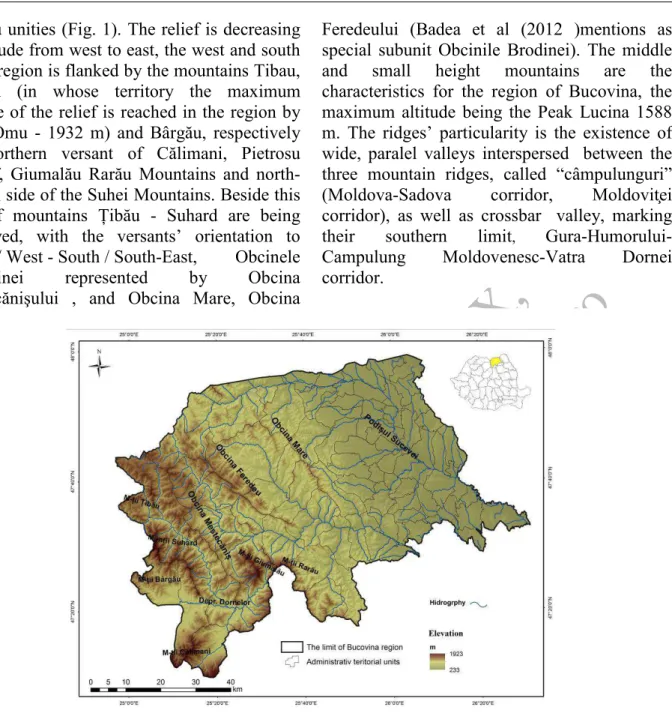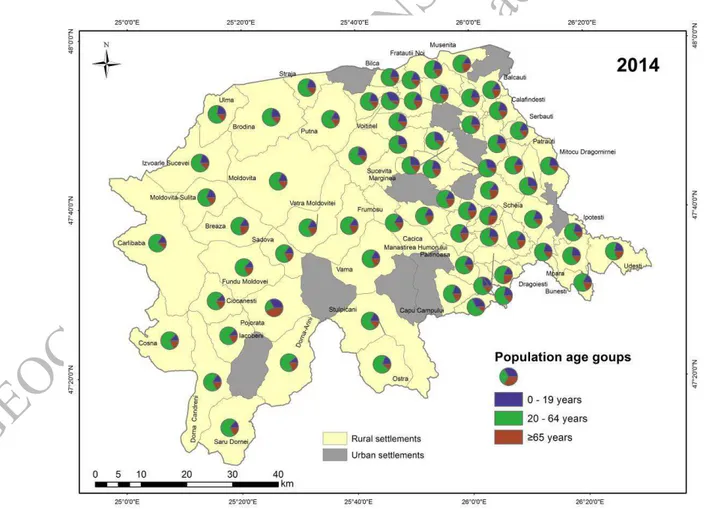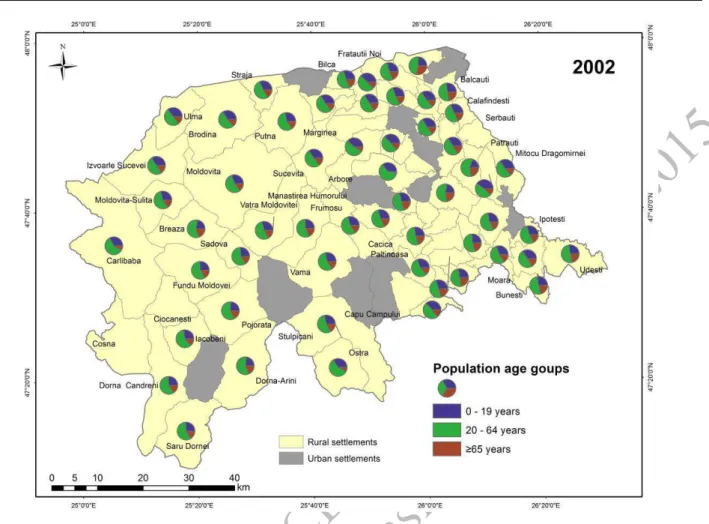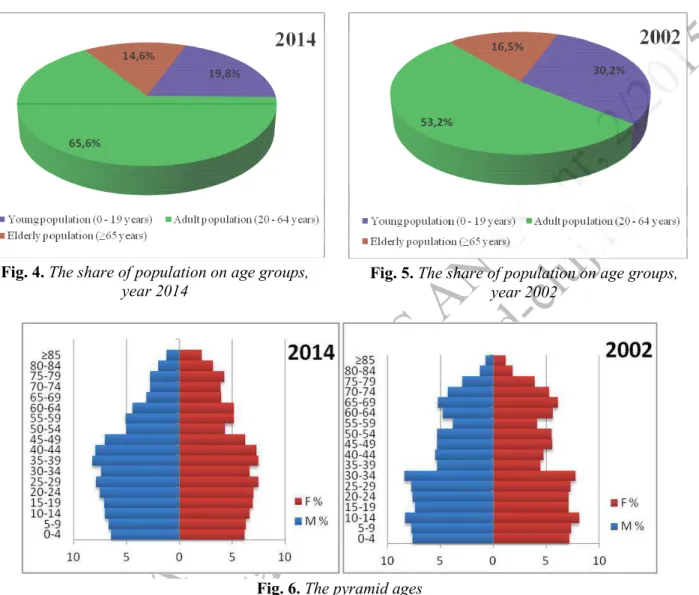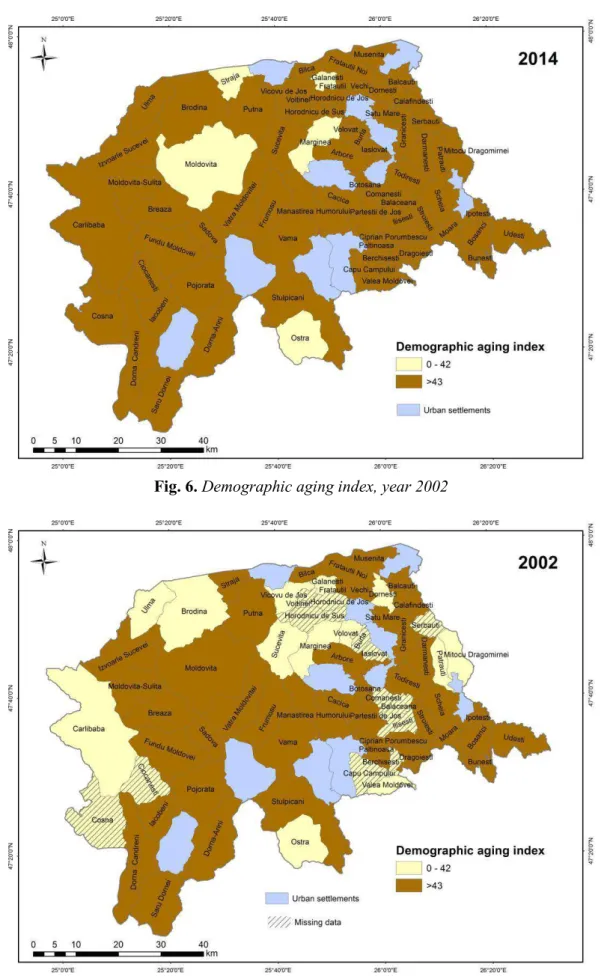GEOGRAPHIA
NAPOCENSIS
AN
IX,
nr, 2/2015
geographianapocensis.acad-cluj.ro
THE STRUCTURE ANALYSIS OF POPULATION
BY AGE GROUPS IN THE RURAL AREAS OF BUCOVINA
NICOLETA ILEANA MORAR (BUMBU)1
Abstract: - Thestructure analysis of population by age groups in the rural area of Bucovina desires to create a recent image of the rural population by age groups in the region of Bucovina , provided that after the year 2000 have occurred socio – economic changes with repercussions on the demographic component. The structure analysis by age group will be based on the share of population indicators on the major age groups, the share of population by age and quinquennial gender illustrated by age pyramid, the index of demographic aging and age-dependency ratio. This study is definitely needed in forecasting future regional development objectives and measures.
Key-words: Bucovina, population structure on age groups, population’s aging
1 Introduction
In a region where the landscape is diversified, with mountain and plateau, the population’s dynamics has experienced considerable changes over time given the existing historical and economic events. According to Pressat (1974) “any population can be considered as a whole into which a number of persons remain within a certain time period (while attendance) and get out”. The three moments captured by the above-mentioned author (entries, presence, outputs) are essential in capturing the evolutionary characteristics of population. Distinguishing the categories of subpopulation and their brief analysis within a demographic complex is of a great importance in defining the role and the location of individuals in the population’s reproduction process and defining the economic activities and the social organization (Sora et al, 1966). In terms of structural cognition of population it can be shown the aging or rejuvenation trends of the population, a fact with major repercussions in the evolution of society.
Recent studies on population in Bukovina region were made either in general papers regarding the entire region of Moldavia where the population is treated sequentially, either in publication on smaller areas of the mentioned
region. Among the authors who were concerned by this topic are Băcăuanu (1980 ), Iaţu (2003 ), Iosep (1972, 1983), Istrate ( 2008).
2 Study area
Bucovina region is located in the north-eastern part of Romania in a place with a great history, whose consequences are still felt today. One of the historical events effects is the very own toponym. The existence of Bucovina, as historical province dates back to 1775, when northern Moldavia was ruled by the Habsburg Empire. Without dwelling on the past history of this space, geo-demographic changes that have occurred in this area in that period are unquestionably important for the further development of Bucovina. The delimitation of the region was based on historical criteria, namely on the basis of Art. II of the Habsburg Empire’s Convention with Romania in 1887. Because this paper has as main pillar, the rural settlement, extrapolating the territorial administrative entity, and given that historical limit established under 1887 does not overlap with the current territorial administrative units, it is impiety considered that the analyzed territory’s limits to include the entire surface of the respective villages. From the point of view of the landscape, Bucovina is represented by two distinct relief units: the mountain and
1
GEOGRAPHIA
NAPOCENSIS
AN
IX,
nr, 2/2015
geographianapocensis.acad-cluj.ro
plateau unities (Fig. 1). The relief is decreasing in altitude from west to east, the west and south of the region is flanked by the mountains Tibau, Suhard (in whose territory the maximum altitude of the relief is reached in the region by Peak Omu - 1932 m) and Bârgău, respectively the northern versant of Călimani, Pietrosu Massif, Giumalău Rarău Mountains and north- eastern side of the Suhei Mountains. Beside this line of mountains Țibău - Suhard are being displayed, with the versants’ orientation to North / West - South / South-East, Obcinele Bucovinei represented by Obcina Mestecănişului , and Obcina Mare, Obcina
Feredeului (Badea et al (2012 )mentions as special subunit Obcinile Brodinei). The middle and small height mountains are the characteristics for the region of Bucovina, the maximum altitude being the Peak Lucina 1588 m. The ridges’ particularity is the existence of wide, paralel valleys interspersed between the three mountain ridges, called “câmpulunguri” (Moldova-Sadova corridor, Moldoviţei corridor), as well as crossbar valley, marking their southern limit, Gura-Humorului-Campulung Moldovenesc-Vatra Dornei corridor.
Fig. 1. Study area
The Plateau region of Bucovina is part of Suceava Plateau, comprising a series of plateaus and valleys with parallel arrangement, continuing the direction of orientation of mountain units. Among them Volovăţului Plateau, Liteni Plateau, which develops in South Liteni Depression, Vultureşti Plateau, separated from Dragomirnei Plateau through Radauti Depression in the north, continuing southeast with Suceava Corridor. From the administrative point of view in the region of Bucovina includes a number of 77 administrative territorial units (of which 11 are towns) and 217 rural
settlements (fig. 4). Because the work focuses on rural settlements, their number is reduced to 68 localities (212 villages).
3
Work methodology
GEOGRAPHIA
NAPOCENSIS
AN
IX,
nr, 2/2015
geographianapocensis.acad-cluj.ro
2002. Based on these data was performed a comparative analysis of the share of population on adult age groups , they have emphasized similarities and differences in the age structure of the population in 2002 and 2014, as well as an analysis of indicators that illustrate the aging of the population.
4
Results and discussions
In the region of Bucovina, at the level of the administrative and territorial units from the rural area, the situation of the population structure in adult group age it is represented by the fact that more than half of them have elderly population share superior to the regional average. Among them are mentioned the localities Bălăceanca (24.7%), Drăgoieşti (24.4%), Todireşti (21.5%), Breaza (21.3%), Muşeniţa (21.2%), Udeşti (19.3%) Dărmăneşti (18.8%), Pârteștii de Jos (18.6%), Bălcăuţi (18.5%), Botoşana (18.4%), Frumosu (18.2%),
Dorna Arini (18.2%), Comănești (18.1,%) and Stroieşti (18.1%) (Fig. 2.). On the opposite side are the localities where the elderly population has a lower share regarding the average of the region, among them being Votinel (8.1%) Marginea (8.4%), Valea Moldovei (9.2%), Pătrăuţi (9.5%), Iaslovăţ (10.2%) or Ostra (10.3%). Comparing the values for the adult age groups from 2014 with the ones in 2002, considerable differences can be observed especially in young and elderly population (Fig. 3.). Negative values of the percentages values differences of population by age group records in all administrative units, except Sucevita (1.3%) and Iaslovăţ (0.4%), but are highlighted localities such as Gălăneşti, Fundu Moldovei, Cârlibaba , Bălcăuţi, Ostra, Dorna Arini, Straja, Manastirea Humorului, Vama, where differences pass 17 percents. This is due to the decreased birth rates and international migration of population with age not exceeding 20 years.
GEOGRAPHIA
NAPOCENSIS
AN
IX,
nr, 2/2015
geographianapocensis.acad-cluj.ro
Fig. 3. The share of population on age groups at U.A.T- level, year 2014Regarding the differences between the adult population of 2014 and 2002, the overall situation is that its share is increasing in the territorial administrative units as a result of natural dynamics of the population, especially in localities such as Cârlibaba , Ostra , Gălăneşti , Pojorâta ( > 20% ) . Differences of less than 5% occur in localities as Fratautii Vechi, Valea Moldovei and
Islovat. Correlating elderly population values between the two time units, there are significant changes in the localities Bosanci , Suceviţa , Volovăţ , where the share of elderly population has increased more than 10 percent in the last 12 years. However, are notable territorial administrative units in which the elderly population has encountered a diminution, this fact being represented by the localities Fundu Moldovei, Manastirea Humorului or Straja.
The regional rate in 2014 for the population aged 0-19 years is 20% of the total population, while older population has a share of 14%.
Compared to 2002 we can see that there are differences between the values of the population aged 0-19 years, a difference of about 10 percent.
This is explained by birth rate values in 2002, higher than those recorded in the year 2014. The natural effect of this turned out to be the growth of adult age population in the year 2014 by approximately 7 percent.(Fig. 4, 5)
GEOGRAPHIA
NAPOCENSIS
AN
IX,
nr, 2/2015
geographianapocensis.acad-cluj.ro
representative pyramid’s central sector for year 2014 is the effect of the existence of a higher share of the population aged up to 35 years. The
thickening of the pyramid is due to the considerable increased number of elderly people, due to the decrease of mortality rate.
Fig. 4. The share of population on age groups, year 2014
Fig. 5. The share of population on age groups, year 2002
Fig. 6. The pyramid ages
To analyze the demographic aging index, an expression of the ratio of the elderly and young population, the threshold value between the rejuvenating and aging population is 42% (Vert, 2001). As result of the analysis of demographic aging index were noted some differences in the territorial administrative units, but before presenting this situation in the year 2014, it has to be clarified that reporting is done only rough territorial entities with administrative functions at the time of the census.
In figure 5 and 6 it can be seen that although in 2002 there was a significant number of localities in the aging process, at the level of 2014 their number increased considerably, the population with rejuvenating tendency being specific to
GEOGRAPHIA
NAPOCENSIS
AN
IX,
nr, 2/2015
geographianapocensis.acad-cluj.ro
Fig. 6. Demographic aging index, year 2002GEOGRAPHIA
NAPOCENSIS
AN
IX,
nr, 2/2015
geographianapocensis.acad-cluj.ro
4 Conclusion
The study made on the population structure by age groups in region of Bucovina it had resulted that the main dysfunction is the aging process intensity. There are multiple implications manifested by the demographic situation of the region on the economic, social, territorial and functional spectrum, the synergistic character of the region is thus put into ambiguity.
The population aging process can take two forms due to "lower" and / or "top" (Barthelemy et al, 2009), as observed in this study, through the decline of fertility and birth rate, but also through life extension in 2014 the age percentage over 85 years being 1.7%, compared to 2002 it increased 0.8%. Thereby, in the region of Bucovina, is visible the bottom to up age tendency of the population. The consequence of demographic aging is the best represented by the contribution that the age group over 64 years manifests in the dependency ratio.
Along with the population that is 19 years old, the older population forms the inactive segment inside the demographic component, which is manifested by an increased pressure on the active population. In the year 2014 the average dependency ratio is 0.75, unlike 2002 when this indicator was 0.87, i.e. at the level of 2014 an inactive person was supported by 1.3 active people, while in 2002 an inactive person was supported by 1.1 people. The situation of the territorial and administrative units of the region presents almost entirely a diminished value of the dependency ratio in 2014 compared to 2002, except for locality Breaza. In 2014, the locality with the highest dependency rate was Valea Moldovei, with a value of 1.02, while the lowest was recorded in the village Iacobeni (0.5). The biggest differences between the existing values in the years 2002 and 2014 are characteristic for the localities Gălăneşti, Muşeniţa, Bălcăuţi and Pătrăuţi.
Socio-economic changes occurred over time have shaped important segments of the population. To support this idea is sufficiently to remember the precarious economy of Romania
along with the crisis in most of the sectors, the scale of the active population international migration in purpose of work searching, which was manifested on population structure by misbalancing the population on age groups. In addition to these causes, changes regarding the life expectancy at birth, improving the access to sanitation and family planning have issued a decline of the fertility rate approximately throughout the region, which obviously affects the birth, and also reduces mortality.
Bucovina’s major demographic dysfunction is the population’s accelerating aging, given that at least the studied Plateau area was considered an important demographic reservoir. The evolution of this deployment process knows a "top" in the elder population, and a "bottom" in the young population.
Knowing of the population age structure is an important component in determining the objectives and the measures of territorial development projects.
REFERENCES
[1] BARTHELEMY, P., GRANIER R., ROBERT M., (2009), Demografie și societate, Institutul European, Iași
[2] BĂCĂUANU, V., BARBU, N., PANTAZICĂ, M., UNGUREANU, AL., CHIRIAC, D., (1980),
Podișul Moldovei. Natură, om, economie,
Editura Științifică și Enciclopedică, București. [3] IAȚU, C., (2003), Depresiunea Rădăuţilor -
studiu de geografie umană, Editura Corson, Iași
[4] IOSEP, I., (1972), Câteva considerații geografice privind populația și așezările omenești din județul Suceava, extras din Comunicări și referate. Geografie, pag 47-62, Casa Corpului Didactic, Suceava
[5] IOSEP, I., (1983), Tipologia așezărilor rurale din Obcinele Bucovinei, extras din Studii și cercetări de geografie, pag. 93-102, Societate de științe geografice, Suceava
[6] ISTRATE, M., (2008),Relațiile urban - rural în Moldova în perioada contemporană, Editura Universității „Alexandru Ioan Cuza”, Iași [7] PRESSAT R., (1974), Analiza demografică,
GEOGRAPHIA
NAPOCENSIS
AN
IX,
nr, 2/2015
geographianapocensis.acad-cluj.ro
[8] ROTARIU, T., (2009), Demografie și sociologia populației. Structuri și procese demografice, Editura Polirom, Iași
[9] SORA, V., HRISTACHE I., MIHĂESCU, C., (1996), Demografie și statistic social, Editura Economică, București
[10] VASILCU, D., (2007), Valea Moldovei în sectorul carpatic – studiu de geografie umană, Editura Universității Suceava, Suceava
[11] ***Anuarul Statistic al județului Suceava, Ediția 2003, Direcția Județeană de Statistică, Suceava
[12] *** Date statisitce privind numărul populației pe grupe de vârstă la data de 1 iulie 2014.
[13] This paper has been prepared with the financial support of the project “Quality
European Doctorate - EURODOC”, Contract no. POSDRU/187/1.5/S/155450, project co-financed by the European Social Fund through the
